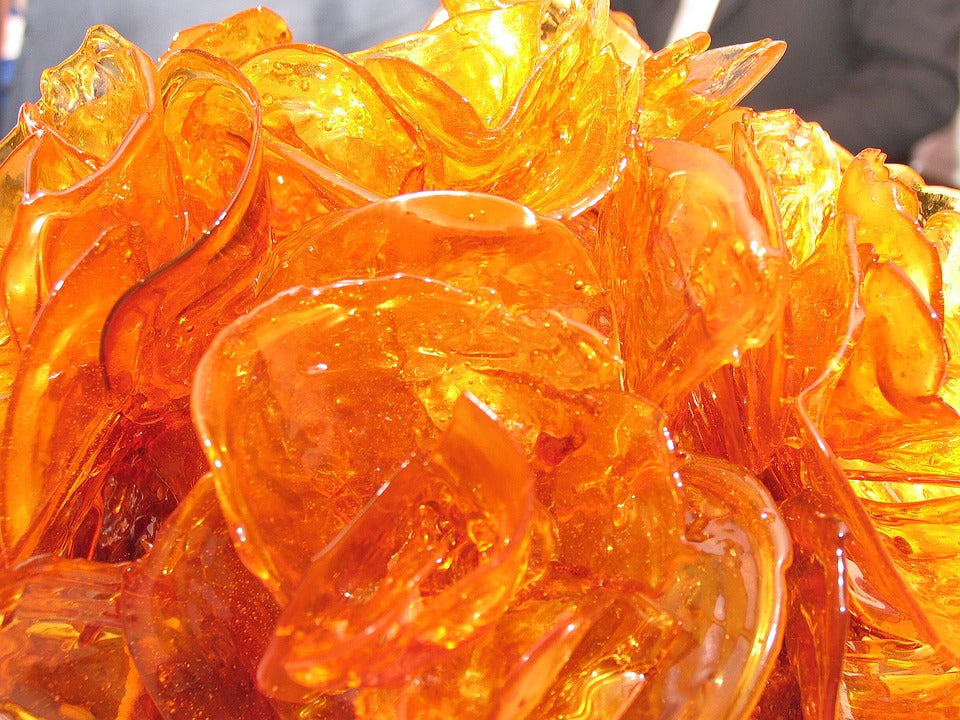
It's National Caramel Day!
I know you've been waiting all year long...It's finally April 5th - National Caramel Day!! I love this sugary confection because it embodies everything that I love about cooking. Technique, artistry, science, craft, history, romance. In this blog post we're going to explore all of those and even more, like high-altitude! Sit back, grab a cup of coffee get ready for a treat. Here comes caramel!
Technique & Science:
Simply put, caramelization is the removal of water from sugar by applying heat. The Classic Caramel recipe (click to see the recipe) that I have shared with you starts with a little water and corn syrup, just to make it a little easier in the beginning. You can make caramel simply from sugar in a hot pan. But it's not as simple as that. You've probably seen the results on popular cooking competition shows when someone decides it's a good idea to make a caramel with a 30 minute time challenge. It almost never ends well. Take your eyes off for a minute and it's game over.
When we're talking technique there are some tips and tricks that make all the difference. Remember that no-stirring thing that we're always talking about? Well, this one will test your patience and your strength of will. Add the ingredients to the pan, swirl if you really have to, and leave...it...alone! Stirring, especially at this altitude, will cause your sugar to seize. And trust me, you don't want that! Do not stir it, do not swirl it, do NOT follow the advice to use a wet pastry brush to wipe down the sides. Just leave it alone. And depending on your cook top, you might have to watch it cook and boil away for up to 20 minutes, maybe even more. It takes time and patience to make a perfect caramel.
That's the biggest technique - patience! But here are a couple of other tips to help along the way:
· Start on low heat until your sugar dissolves, then turn your heat up to medium-high.
· For our altitude shoot for a temperature between 308-338. I generally don't use a thermometer for caramel, but rather go by color.
· Remember!! Your caramel will continue to cook if you leave it in the hot pan. To immediately slow the cooking place it into a cool stainless steel bowl. Avoid glass unless you know that is thermo shock resistant.
· Use a nonstick saucepan. Rarely will I ever recommend this, however, in this case it helps prevent sugar crystals from forming inside the pan.
· If sugar crystals do begin to form, you can use an acid to try to save your caramel. Add a small squirt of lemon or a very light touch of vinegar. I have had both success and failure with this method, but it's worth a shot in the heat of the moment.
· If you are adding cream or liquid at the end to make caramel sauce, it is going to bubble and spit. Add it VERY slowly until the hot caramel temperature comes down enough to accept the cold liquid that is being added.
Artistry & Craft:
So, we've covered some of the technique. But this classic confection also takes a little artistry and craft to master. There will probably be a time at some
point where you will fail. Pick yourself up and try again. I once had my caramel seize multiple times for a photo shoot and realized that it was the 8500ft in Woodland Park that was tripping me up. It took me 5 tries, a panicked call to my mom and I made caramel until midnight. But guess what? I won. And caramel is no longer my nemesis.
I mentioned earlier that I go by color rather than temperature. For a purist or a pastry chef, the temperature is very important. But for me, whipping up a quick caramel sauce is all about getting the color just right. Too light and you don't get the richness, too dark and it ends up bitter and burnt. And you have to stop at just the right time. I suggest about two shades from the result that you are looking for.
I also use this recipe for sugar work like croquembouche and decorative sugar work for desserts, like spun sugar. In that case, you want the flavor and the color to enhance your overall end result, so time and temperature is a little more tricky. To keep it warm while you are working, place the caramel in a double boiler over simmering water. That way you can dip in as needed and not burn your sugar. Hint: liquid sugar is HOT! Practice with care.
I find part of the artistry of it not panicking when something goes wrong. Yes, it's frustrating. But learn WHY is happened (you can always ask us!) and then HOW to fix it. The confidence from the knowledge of knowing exactly why it is happening will help you become more intuitive about how to correct it. And practice. Practice, practice, practice! This is not a one trick pony - it takes work!
So get into your kitchen and start flexing those cooking muscles. You have everything you need - sugar & water!! Experiment, play and have fun. Caramel may be technical, but that doesn't mean that you can't master it in your very own kitchen and become a caramel expert.
And once you master stove top caramel, it's time to move onto these fun recipes! (click to see the recipes)
